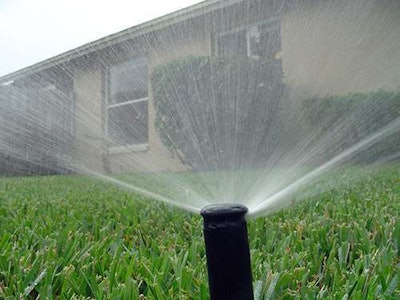
Customers rarely complain about money spent that has visible result – new plantings or a patio, for example. But no one likes expensive, unseen changes that merely repair or maintain existing systems or installations.
Still, if your customer’s irrigation system needs to be repaired or upgraded (either to correct deficiencies as a result of an irrigation audit or to reflect new planting needs), there has never been a better time to do it. In most cases, an irrigation upgrade – even if the previous system is less than 10 years old – will not simply replace an exiting system; it will vastly improve on it.
Those improvements are largely unseen (at least, until the water bill arrives) so it will be up to you to help customers see the job as not just as a drain on their bank balance, but as an investment.
“Upgrades usually tend to replace old mechanical style controllers with newer electronic ones that have much more flexible programming capabilities,” says Tom Penning, president of Irrometer. “Most landscapers would also propose upgrades when watering restrictions change and the control system on site is not capable of meeting the new restrictions. They include new emission devices (sprinklers) or drip components, valves, controllers and sensors (moisture, rain, freeze, flow). Also the integrity of the piping system is checked and repaired as necessary. Often some new piping is required as additional valves may be added.”
If an irrigation upgrade is requested to take advantage of smart water technology, or to deal with new water restrictions, your client is probably already aware of the advantages of fine-tuning and upgrading their existing system. But if the upgrade is requested for a malfunctioning system, or to cope with additional plantings, a little education may be in order.
“Comparing water bills is a quick way to see the return on investment,” says Brent Mecham, industry development director for the Irrigation Association. “Other factors that should be considered can include the savings in other areas of grounds management including reduced or easier mowing, reduced fertilizer and other chemical applications etc. because water is being managed correctly. All of these will impact the ROI and can greatly increase the ROI when factored in. Most people just look at the water bill when in reality the whole landscape maintenance picture should be considered.”
If someone is already doing active water management an electronic controller may not save any water, but it will save a lot of labor,” Mecham notes. “But we find most people get into a ‘set it and forget it’ water management mode and then the sprinkler system is no longer responding to the plant’s need for water,” he adds. “The Environmental Protection Agency and their Water Sense program have identified landscape water management as a target that will yield significant water savings in the urban environment without changing the landscape. The new ‘smart’ controllers when properly programmed and set up will probably yield a 20 percent to 30 percent reduction in water use. However the new controllers will not fix under-performing systems. What we are seeing is the ‘smart’ controllers deliver great results, but the sprinkler system needs to be performing optimally to get the desired results which are great looking landscapes on less water.”
When designing an upgrade for an existing system, here are a few things to consider:
Local water restrictions/windows/rebates
Check on local restriction, water windows and rebates before starting work. Keep in mind that these may differ, even in neighboring communities.
Sprinklers/nozzles
Sprinklers and nozzles have changed dramatically recently; newer sprinklers are tougher and are more likely to have pressure regulation. Consistent pressure regulation ensures a uniform droplet size, which creates even watering.
Remote control
Today, nearly all irrigation controllers come with remote control capabilities – or are designed for future upgrade to remote control (either by the original manufacturer or third-party vendors). Remote control is especially important for large or commercial installations, but can make the system much easier to audit and troubleshoot.
Rain shutoffs
New regulations in many states and water districts require rain shutoffs now. It saves water, and saves your customer money.
Future expansion
Plan ahead for future upgrades or expansions. If the customer has any potential for growth or even new plantings, take into account not only whether the controller’s maximum station capacity water window and pipe size will service the upgrade you are installing, but future ones as well.





